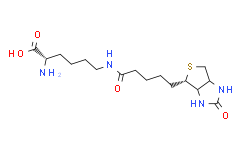| 英文别名 |
Biocytin;N6-[5-[(3aS,4S,6aR)-Hexahydro-2-oxo-1H-thieno[3,4-d]imidazol-4-yl]-1-oxopentyl]-L-lysine;(2S)-6-[5-[(3aS,4S,6aR)-2-oxo-1,3,3a,4,6,6a-hexahydrothieno[3,4-d]imidazol-4-yl]pentanoylamino]-2-aminohexanoic acid;Biocytin;H-L-Lys(Biotinyl)-OH;H-Lys(biotinyl)-OH;H-Lys(biotinyl)-OH(Biocytin);N'-Biotinyl-L-lysine;(S)-(-)-Pindolol;Bct,Nε-(+)-Biotinyl-L-lysine;Biotinyl-L-lysine;N6-[5-((3aS)-2-oxo-(3ar,6ac)-hexahydro-thieno[3,4-d]imidazol-4t-yl)-pentanoyl]-L-lysine;N6-[5-((3aS)-2-oxo-(3ar,6ac)-hexahydro-thieno[3,4-d]imidazol-4t-yl)-valeryl]-L-lysine;N6-D-Biotinyl-L-lysine;Ne-Biotynyl-L-lysine;Bct;Nε-(+)-Biotinyl-L-lysine;(+)-Biocytin;C16H28N4O4S;epsilon-N-Biotinyl-L-lysine;G6D6147J22;n6-{5-[(3as,4s,6ar)-2-oxohexahydro-1h-thieno[3,4-d]imidazol-4-yl]pentanoyl}-l-lysine;(2S)-6-{5-[(3aS,4S,6aR)-2-oxo-hexahydro-1H-thieno[3,4-d]imidazolidin-4-yl]pentanamido}-2-aminohexanoic acid;biotinyllysin;N6-(
|



 扫码关注公众号
扫码关注公众号